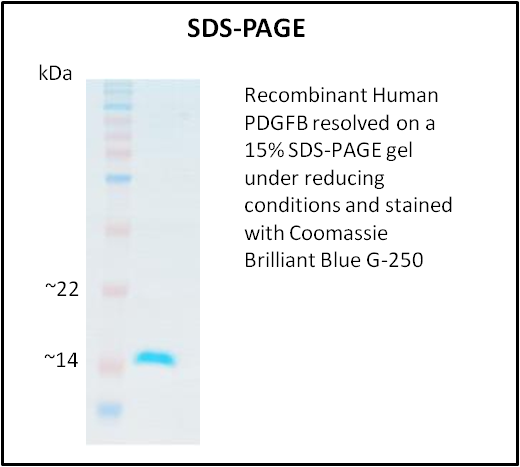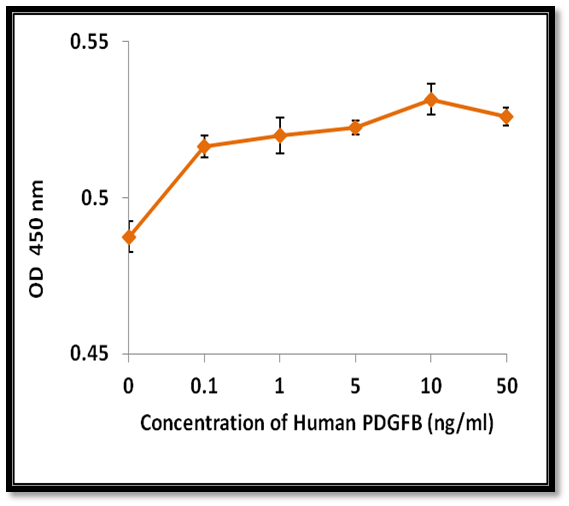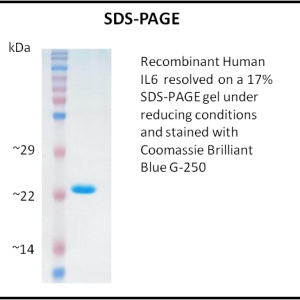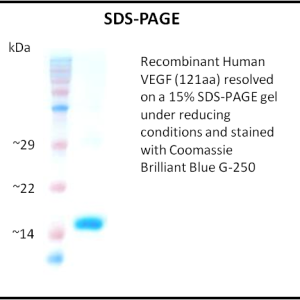Product Details
- Product Name: Recombinant Human PDGFB
- Product Type: Growth Factors & Cytokines
- Catalog Number: Z100355
- Unit Size: 10 µg
- Species: Human (Homo sapiens)
- Gene Symbol: PDGFB
- Gene ID: 5155
- Accession Number: P01127
- Aliases: IBGC5, PDGF-2, PDGF2, SIS, SSV, c-sis
- Source: E. coli
- Molecular Weight: ~16 kDa (disulfide-linked homodimer)
- Form: Lyophilized powder
- Purity: > 95% (SDS-PAGE)
- Endotoxin Level: < 1.0 EU/µg (LAL method)
- Appearance: White lyophilized powder
- Formulation: Lyophilized from a 0.2 µm-filtered PBS solution
- Function: Stimulates NIH 3T3 cell proliferation; ED₅₀ < 0.5 ng/mL
- Storage:
- Lyophilized: –70°C (≥ 12 months)
- After reconstitution:
- 2–8°C (≤ 1 month)
- –20°C (≤ 6 months, with carrier protein)
- Avoid repeated freeze/thaw cycles
- Shipping: Dry ice
- Usage: For research use only; not for diagnostic or therapeutic applications
Overview
Recombinant Human Platelet-Derived Growth Factor subunit B (PDGFB) is a disulfide-linked homodimeric protein that plays a critical role in regulating cell proliferation, migration, and differentiation. It is stored in platelet alpha granules and released during platelet activation, functioning via PDGF receptor-mediated signaling. PDGFB is essential for embryonic development, wound healing, and vascular remodeling. Dysregulation of PDGFB signaling is associated with various pathologies, including atherosclerosis and proliferative retinopathies. This E. coli-derived recombinant protein retains high biological activity and is suitable for diverse cell-based assays.
Key Features and Benefits
- Biologically Active: Exhibits ED₅₀ < 0.5 ng/mL in NIH 3T3 cell proliferation assay.
- Low Endotoxin Level: < 1.0 EU/µg as determined by LAL method—appropriate for sensitive experimental systems.
- High Purity: > 95% confirmed by SDS-PAGE ensures reliable and reproducible results.
- Native Homodimer Structure: Maintains disulfide-linked configuration for optimal receptor binding.
- Stable Lyophilized Form: Supports long-term storage and consistent assay performance.
Reconstitution Instructions
To ensure optimal bioactivity and stability:
- Centrifuge the Vial: Briefly spin to collect the powder at the bottom.
- Reconstitute: Add sterile distilled water to a final concentration ≥ 0.1 mg/mL.
- Mix Gently: Swirl to dissolve; avoid vigorous shaking or vortexing.
- Dilute for Use: Further dilute in the desired buffer containing carrier protein.
- Storage: Store reconstituted protein at 2–8°C (≤ 1 month) or –20°C (≤ 6 months).
Quality Control (QC)
- Purity: Verified by SDS-PAGE
- Endotoxin: Assessed using Limulus Amebocyte Lysate (LAL) method
- Bioactivity: Confirmed in NIH 3T3 cell proliferation assay
Caution
This product is intended for research use only. It is not to be used in humans or animals for therapeutic or diagnostic procedures.
Disclaimer
- For research use only.
- Not for human or veterinary use.
- Not for diagnostic or therapeutic purposes.
- The supplier assumes no liability for the misuse of this product.
- Users are responsible for compliance with institutional and regulatory guidelines.




